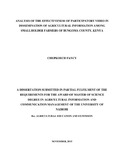| dc.description.abstract | Participatory video is just one among the tools that are used for disseminating agricultural information. The use of video has been seen as catalyst to effective knowledge transfer to rural areas of the developing world. However, the use of participatory video in dissemination of agricultural information to farmers only started to take root in developing countries few years ago thus necessitating for more studies to establish its effectiveness. This study therefore endeavoured to study the farmers’ perception, application and effectiveness of participatory video in dissemination of agricultural information among smallholder farmers in Kabuchai Division, Bungoma County. The study employed a descriptive survey research design to collect data from 120 smallholder farmers half of whom had been trained through participatory video and were purposively selected from an existing list of adopters and the other half were selected randomly. The data was collected using a semi-structured questionnaire. The data was analyzed using SPSS and presented using frequency tables, percentages, charts, graphs, averages, and regression model. The results of regression model showed that 17% of the study factors explained the change in the effectiveness of participatory video as a medium for dissemination of agricultural information. The study further confirmed that income of farmers, group membership, access to credit and distance to extension offices as factors affecting the effectiveness of participatory video in dissemination of information. This was evidenced through p-values of 0.02, 0.01, 0.08 and 0.027 respectively. The findings also revealed that majority of farmers (75%) rated participatory video approach as effective while 25% rated it as not effective. The findings of the study further revealed that a great majority of farmers (83%) believed that participatory video encourages farmers to try new agricultural technologies. The study findings indicated the comparative advantage of PV over face to face interactions with extension agents lies in the following reasons; ability of PV to demonstrate (30%), storage of information for future reference mentioned (21%), ease of sharing information from one farmer to the other (16%), ease of availability (15%), larger geographical reach 12%) and ease of understanding (7%) respectively. The study concludes that participatory video is positively perceived among the farmers as an effective tool to supplement or complement the face-to-face extension. It also concludes that participatory video encourages the adoption of new agricultural technology and that participatory video use among farmers is determined by farmer’s membership to a group, income levels and distance from extension officers. The study thus recommends that there is need to integrate use of participatory video to compliment and supplement the existing agricultural extension approaches to reach more farmers beyond the study area and encourage horizontal form of information sharing. Further, the study recommends that a study should be conducted to assess the cost-effectiveness of participatory video against the conventional extension approaches. | en_US |



